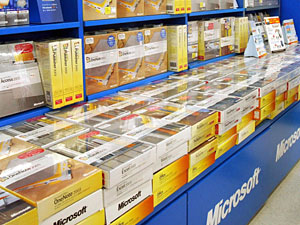|
Audio
Photos
Resources
Respond to this story
|
Microsoft to pay millions to Minnesota consumers, schools
July 1, 2004
 |
| Hagstrom and his team said Microsoft used monopoly power and illegal business tactics to overcharge for Windows, Word, Excel and Office. (Photo: YOSHIKAZU TSUNO/AFP/Getty Images) |
Minneapolis, Minn. — According to the deal, Microsoft will give consumers and businesses a maximum of $175 million. This amount is less than half what plaintiffs originally sought. But by the standards of previous Microsoft settlements, it's a big one. Out of 13 settled class-action suits around the country, only Florida and California were bigger, and both have populations much larger than Minnesota.
This was the only case so far to go to trial. Plaintiffs' lawyer Richard Hagstrom says that made all the difference.
"It took seven weeks of trial to get to these numbers. Without disclosing those discussions, us taking this case to trial greatly benefited Minnesota consumers and businesses," Hagstrom said.
Hagstrom and his team said Microsoft used monopoly power and illegal business tactics to overcharge for Windows, Word, Excel and Office. Microsoft claimed its software succeeded on its own merits, and the settlement contains no admission of wrongdoing by the company.
Microsoft lawyer David Tulchin believes the company was winning the case, but the risk was too great.
"It was prudent for the company to consider some solution that would wind up costing it far less money than a resultion if we had lost and lost badly. I'm not predicting that, but you have to be realistic," he said.
Here's how the settlement works: Anyone who bought the covered Microsoft software for use in Minnesota between 1994 and 2003 is eligible. This includes companies based out of state. Starting July 6, letters and e-mails will go out to known class members, but most people need to go to a Web site or call a toll-free number to make their claim.
Each software license you bought gets you a voucher in return. Windows, for example, gets you a $15 voucher; Microsoft Office is worth $23.
These vouchers are good for purchase of any hardware or software -- Microsoft competitors included. Just send in your receipts, and they'll send you cash.
This can add up for big companies. Plaintiffs' lawyers say General Mills and HealthPartners are already doing the numbers; the latter stands to get about $300,000 back.
The deal still needs final approval from the judge in October. The first vouchers will be issued shortly thereafter, and people have until February to file their claims.
At that time, we'll know how much is left over. This is where the schools come in. Microsoft will give half the unclaimed vouchers to the Minnesota Department of Education to spend on technology. Microsoft lawyer Tulchin says its something the company has put into settlements in previous states.
"Schools and school districts in poorer neighborhoods can have the benefit of vouchers which they can very easily turn into cash so that we hope underprivileged students will attend schools where the digital divide has been closed somewhat," he said.
Bill Walsh, an education department spokesman, says if past states are any guide, it will be unusual if even 20 percent of eligible class members claim their vouchers. This would mean $70 million of technology money for Minnesota schools. Compare that to the amount of state money allocated for school technology this year: Zero.
"It's a huge infusion of money for technology, no doubt about it," Walsh said. "The needs are easy to identify -- the software and hardware needs at the school level. Helping schools do more with data, analyzing test score data to improve instruction. We'll obviously sharpen the pencil on it moving forward, now that we know the details."
There are other goodies hidden in the settlement. The U of M computer science department will get $5 million in cash. A local legal aid organization gets $2.5 million.
And one other number in the settlement rivals what the schools will get. Microsoft will pay up to $60 million in fees to the law firms that brought the case against them.
|
News Headlines
|
Related Subjects
|
